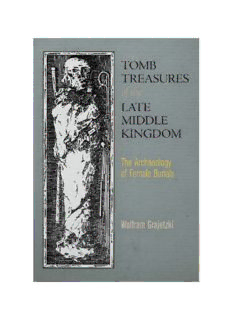
Tomb Treasures of the Late Middle Kingdom: The Archaeology of Female Burials PDF
Preview Tomb Treasures of the Late Middle Kingdom: The Archaeology of Female Burials
Tomb Treasures of the Late Middle Kingdom This page intentionally left blank Tomb Treasures of the Late Middle Kingdom The Archaeology of Female Burials WoLFrAM GrAjeTzKi University of Pennsylvania Press Philadelphia Copyright © 2014 University of Pennsylvania Press All rights reserved. Except for brief quotations used for purposes of review or scholarly citation, none of this book may be reproduced in any form by any means without written permission from the publisher. Published by University of Pennsylvania Press Philadelphia, Pennsylvania 19104-4112 www.upenn.edu/pennpress Printed in the United States of America on acid-free paper 10 9 8 7 6 5 4 3 2 1 Library of Congress Cataloging-in-Publication Data Grajetzki, Wolfram. Tomb treasures of the late Middle Kingdom : the archaeology of female burials / Wolfram Grajetzki. — 1st ed. p. cm. Includes bibliographical references and index. ISBN 978-0-8122-4567-7 (hardcover : alk. paper) 1. Tombs—Egypt. 2. Burial—Egypt. 3. Women—Egypt—History—To 500. 4. Egyptians—Funeral customs and rites. 5. Excavations (Archaeology)— Egypt. 6. Egypt—Civilization—To 332 B.C. 7. Egypt—Antiquities. I. Title. DT62.T6G73 2014 932'.013—dc23 2013024963 For Danielle Darrieux Catherine Deneuve Isabelle Huppert Emmanuelle Béart Fanny Ardant Virginie Ledoyen Ludivine Sagnier Firmine Richard This page intentionally left blank Contents Introduction 1 ChApTer 1 Court Type Burials 17 ChApTer 2 other Burials of Women 94 ChApTer 3 Types of jewelry in Late Middle Kingdom Burials 114 ChApTer 4 The Development of egyptian Burial Customs 135 ChApTer 5 The King and the Women Buried Around him 180 AppenDix The royal Women of the Twelfth Dynasty 189 Chronology 195 Notes 199 Egyptian Tombs and Excavation Report 225 Bibliography 229 Index 249 Acknowledgments 255 This page intentionally left blank introduction The late Middle Kingdom in ancient Egypt, c. 1850 to 1700 BCE, is exceptionally rich in undisturbed burials of women. These tombs are of- ten lavishly equipped with jewelry of the highest quality. Much of this jewelry has been regularly depicted in books on ancient Egypt. The buri- als are not often discussed as a whole, however; the other object types found in them are frequently barely mentioned. In this book my aim is to fill this gap. In the first part I provide a description and synthesis of the latest research on several of the most important late Middle Kingdom burials belonging to women. In the second part I give an overall view of late Middle Kingdom burial customs, again with the main focus on burials of women. An advantage of studying female burials is that in them certain trends in burial customs are particularly visible, such as concentration on the social identity of the tomb owner and “Osirification” (discussed in Chapter 4) in the “court type burials.” The technology of jewelry produc- tion, already covered by several other expert studies, is not the subject of the book.1 Studies of ancient Egyptian burial customs often concentrate on in- scribed objects of the funerary industry. These include coffins, canopic jars, shabti figures, funerary papyri, and amulets. Especially from the Rames- side Period onward, these are certainly the most important items placed in the burial chambers, next to or on the deceased. Looking at the whole of Egyptian history and across all social classes, however, the picture is different. A wide range of uninscribed objects was placed in the tomb, in- cluding many items that had already been used in daily life, such as pottery vessels, cosmetic items, tools, and jewelry. Taken together, these latter
Description: